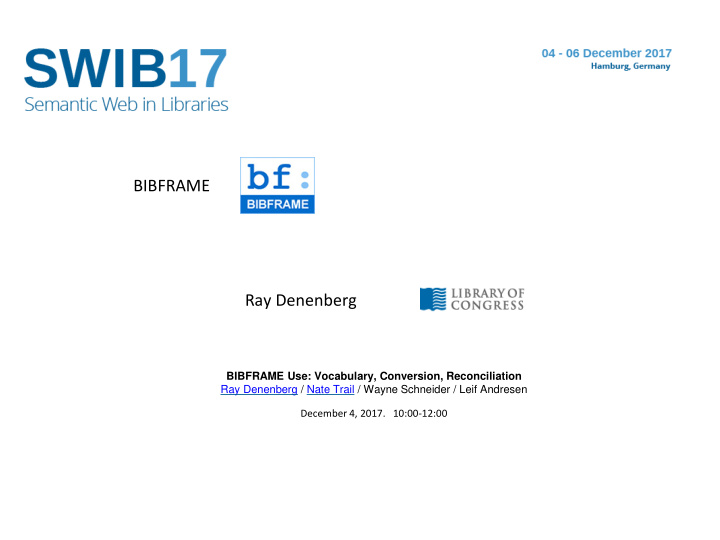



<w1> a bf:Work ; bf:title :title1, :title2 . :title1 [ a bf:Title ; bf:mainTitle “Journal of Dental Research” ] .
<w1> a bf:Work ; bf:title :title1, :title2 . :title1 a bf:Title ; bf:mainTitle “Journal of Dental Research” . Subclass of bf:Title :title2 a bf:Title bf:AbbreviatedTitle ; bf:mainTitle “ J Dent Res ” ] ;
Title Types external to BIBFRAME • af:RepositoryTitle • af:CreatorsTitle • af:DescriptiveTitle • af:TranslatedTitle • af:OriginalTitle • af:ExhibitionTitle • af:FormerTitle • ex:conciseTitle • ex:distinctiveTitle • ex:PreferredTitle
Title Source • :CommonlyKnownTitle • :DevisedTitle • :ReferenceSourceTitle • :AnnouncedTitle • :ContainerSpineTitle • :ContainerTitle • :CreditsTitle • :EmbeddedMetadataTitle • :MediaSurfaceTitle • :MenuTitle • :TitleScreenTitle
BIBFRAME Events
• There is a concert. • The concert is recorded. • A book is written about the concert.
• There is a concert. The concert is an Event . • The concert is recorded. The recording is a Work . • A book is written about the concert. – The book is a Work and the concert is its subject.
Brief digression: BIBFRAME Subjects
Person as subject bf:subject [ a bf:Person ; rdfs:label “John Wilkes Booth” ]
Work as subject bf:subject [ a bf:Work ; rdfs:label “John Wilkes Booth” ] .
Place as subject bf:subject [ a bf:Geographic ; rdfs:label “France” ] .
If no known class fits …
Topic as Subject bf:subject [ a bf:Topic ; rdfs:label “History” ] .
Event as subject bf:subject [ a bf:Event ; rdfs:label ““1964 U.S. Presidential Inauguration” ” ] .
• There is a concert. • The concert is recorded. • A book is written about the concert.
• There is a concert. The concert is an Event . • The concert is recorded. The recording is a Work . • A book is written about the concert. – The book is a Work and the concert is its subject.
Event bf:eventContent bf:subject bf:eventContentOf Work 1 Work 2 video of book about the event the event These two properties created expressly for the event model .
Property pmo:createdFor • pmo: Performed Music Ontology
Event Work bf:relatedTo
Event Work pmo:createdFor Subproperty of bf:relatedTo
Example: a motet celebrating the inauguration of a pope inauguration of motet a pope (Work) (Event) pmo:createdFor
Additional pmo properties • hasEventName • hasInspiration • hasPerformance Event that is the performance of a Work. Subproperty of eventContentOf • recordingOf Subproperty of eventContentOf
Additional pmo Classes • pmo:Concert • pmo:Performance All subclasses of bf:Event • pmo:Festival
… and further subclassed: • Concert – BenefitConcert – ConcertSeries – ConcertTour • Performance – CommandPerformance – FirstPerformance – LivePerformance< – OpenMicPerformance – RecordingSession – Rehearsal – Audition • Festival – MusicFestival
Rare Materials: CustodialEvent ex:CustodialEvent • – ex:Accessioning – ex:Auction – ex: Request – ex: ClaimOfOwnership – ex: Deposit – ex: Destruction – ex: Donation Subclasses of bf:Event – ex: Inheritance – ex: Loan – ex: Loss – ex: Offer – ex: Recovery – ex: Repatriation – ex: Sale – ex: Theft – ex: Transfer
Relationships
relatedTo <WorkA> relatedTo <WorkB>
More Specifically … <WorkA> bf:continuedBy <WorkB> Subproperty of bf:relatedTo
However, you might want to supply the date that the “continuation” took place
Introducing class bflc:Relationship, property bflc:relationship and property bflc:relation <WorkA> bflc: relationship [ a bflc: Relationship ; bflc: relation bf:continuedBy ; bflc:target <WorkB> ; bf:date “10232017” ; ]
<WorkA> bflc:relationship [ a bflc:Relationship ; bflc:relation bf:continuedBy ; bflc:target <WorkB> ; bf:date “10232017” ; ] You can’t express the date using the pattern: <WorkA> bf:continuedBy <WorkB>
other use cases supported by the relationship pattern. • Graceful degradation. You could say (1) <WorkA> ex:xyz <WorkB> Or you could say: (2) <WorkA> bflc:relationship [ bflc:target <WorkB> ; bflc:relation ex:xyz ] Assume the client receiving this rdf does not recognize the namespace ex: Using (1), the client will not make any sense of this. Using (2) it will at least know that WorkB is a resource related to WorkA, even though it won’t know the exact relation.
other use cases supported by the relationship pattern. • Graceful degradation. You could say (1) <WorkA> ex:xyz <WorkB> Or you could say: (2) <WorkA> bflc:relationship [ bflc:target <WorkB> ; bflc:relation ex:xyz ] Assume the client receiving this rdf does not recognize the namespace ex: Using (1), the client will not make any sense of this. Using (2) it will at least know that WorkB is a resource related to WorkA, even though it won’t know the exact relation.
no URI to express relationship <WorkA> bflc:relationship [ bflc:target <WorkB> ; bflc:relation [rdfs:label “ name of relation ” ] ]
Roles/Contributions
First, brief review of how roles were modeled in BIBFRAME 1.0
Roles In BIBFRAME 1.0 <work> relators:aut <person> Says: “ this work has an author, and that author is this person ”
Example (still 1.0) <http://bibframe.example.org/work/2014012522> relators:ill <http://id.loc.gov/rwo/agents/n79021035> .
<http://bibframe.example.org/work/2014012522> relators:ill <http://id.loc.gov/rwo/agents/n79021035> Illustrator Ruth Sanderson castle full of cats
bf1: role is modeled as a relation bf2: as a Contribution
(BF 1) relation : relates a person to a Work: “Ruth Sanderson is the illustrator of ‘Castle full of cats’” (BF 2) contribution : modelled more as an activity “Ruth Sanderson illustrated ‘Castle full of cats’”
What’s the difference?
if you can say: “Ruth Sanderson illustrated ‘Castle full of cats’” Then you can say: “Ruth Sanderson illustrated ‘Castle full of cats’ in 2015 ” Or even: “Ruth Sanderson illustrated ‘Castle full of cats’ in 2015, in New York”
bf:Contribution <http://bibframe.example.org/work/2014012522> illustrator bf:contribution [ a bf:Contribution ; bf:role <http://id.loc.gov/vocabulary/relators/ill > ; bf:agent <http://id.loc.gov/rwo/agents/n79021035 > ] Ruth Sanderson ;
Add date and place of contribution <http://bibframe.example.org/work/2014012522> bf:contribution [ bf:role <http://id.loc.gov/vocabulary/relators/ill > ; bf:agent <http://id.loc.gov/rwo/agents/n79021035 > bf:date “2015” ; bf:place <http://id.loc.gov/vocabulary/geographicAreas/n-us-ny> ] ;
More recommend